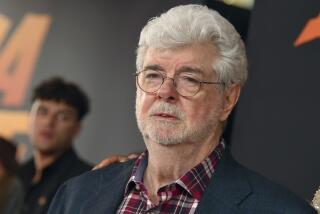Perspective: It’s a brand-news day in Hollywood
The Oct. 30th announcement that the Walt Disney Co. had purchased Lucasfilm, the home of “Star Wars,” for just over $4 billion was met with raptures in the business press about synergies and merchandising and potential growth — all the things routinely expressed when one corporate behemoth gobbles up another. But in this case the effusions may actually be instructive and not just hyperbolic.
Long ago Joan Didion lamented that in Hollywood the art of the deal had replaced the art of the movies, but at least she was talking about deals to make movies. What the Lucasfilm acquisition suggests is that deals are a thing unto themselves and that movie studios are no longer in the movie or even the entertainment business at all. They are in the branding business, and Lucasfilm is one of the biggest brands. It is a brand that is so large it dwarfs any movie, TV show or video game. Just slap “Star Wars” on anything and it is likely to sell.
In the studios’ heyday back in the 1930s and ‘40s, they had one basic task: to make movies. All the other assets they acquired — writers, directors, technicians, stars — were deployed in the service of making films that, moguls hoped, audiences wanted to see. That obviously isn’t to say that the movies weren’t a business. It is simply to say that filmmaking was a rather unusual business — one in which every product was unique and every one a risk.
PHOTOS: ‘Star Wars’ at the box office
Studios could try to reduce that risk — that was basically what stars were for — but there was never a guarantee that people would go to see any particular film no matter who starred in it. And while the studios themselves were a brand of sorts — Warner Bros., MGM, Paramount, RKO and Universal made distinctive pictures — few people went to see a movie because a studio made it. The movies, not the studios, were the thing.
Some say that Walt Disney was the craven pioneer who changed all this when, early in his company’s history, he developed a merchandising arm that peddled dolls, watches, train sets, games and other paraphernalia featuring the studio’s cartoon stars. Thus, it is said, did studios go from making films to selling products — from being houses of art to houses of business.
In Disney’s defense, however, he didn’t make movies to sell products. It was the other way around. He sold products so that he could make movies. For all the gripes about Disney being a greedy entrepreneur who cared only about money, he was actually an artist who cared almost nothing about money and whose studio was almost always in financial straits. In fact, he was so dedicated to the sanctity of his movies that he adamantly refused to make sequels even though he was pressured to follow up “The Three Little Pigs” and even “Snow White” with continuations of the stories.
The movie business — and the Disney Co. — have changed a lot since then. The budgets for movies have skyrocketed along with the marketing costs, so that practically every movie is not only a risk, it is a high risk, which is why studios lust after sequels and familiar characters that are effectively pre-sold to the audience on the premise that those audiences are just as risk averse as the studios. Disney itself demonstrated how dangerous originality can be when it poured well over $100 million into what it clearly hoped would be a new franchise, “John Carter,” based on an Edgar Rice Burroughs series of novels about a Civil War veteran who miraculously finds himself in the middle of a war on Mars. The studio quickly discovered that Burroughs was not a recognizable brand, and the film, though it was no worse than most movies in the genre, bombed.
So now the studio, like all studios, is back to generating films that have already been road-tested for audience receptivity. Presumably, that is why Disney spent just under $4 billion in 2009 to acquire Marvel Comics with its panoply of superheroes and why it has now acquired Lucasfilm. You can call the Marvel heroes and the “Star Wars” characters assets that Disney can exploit in various forms, but they are really less assets than they are labels that obviate the need for traditional assets like movies or TV shows or games. Disney is betting that in this post-modernist entertainment culture, audiences care more about the name “Marvel” or “Star Wars” than about the actual movies or TV shows or video games to which those names are attached.
They have only to look at the last three aesthetically tepid but commercially successful “Star Wars” films for proof, though they could also look at “Thor” or even “Iron Man II” for further confirmation. In effect, Disney is assuming that audiences buy a brand rather a movie.
This is exactly how Disney Chief Executive Robert Iger characterized the Lucasfilm acquisition, calling Lucasfilm one of the “great entertainment properties of all time, one of the best branded.” When studios were trying to create brands by making popular “tent-pole” movies, there wasn’t anything necessarily mutually exclusive between the movie and the brand it engendered. But when studios acquire brands, branding and filmmaking become less a matter of synergy than a zero-sum game, which is to say that branding replaces filmmaking. One gets the feeling that Disney bought Lucasfilm not because it had all sorts of imaginative films it wanted to make using the “Star Wars” characters but precisely because it knew it didn’t need to have any imagination once it got “Star Wars.” When the brand is big enough, it makes the movie irrelevant.
It used to be that the movie created the brand, which is exactly how George Lucas built his empire. Now the brand creates the movie. And it used to be that all the merchandise was ancillary to the movie. Now the movie is ancillary to the merchandise. The holy grail of Hollywood has always been trying to find a way to make movies that sell themselves without the movies necessarily having to be any good. With the acquisition of Marvel and now of Lucasfilm, Disney may have finally found the grail. You don’t need imagination or art. All you need is a brand.
Gabler, author of “An Empire of Their Own: How the Jews Invented Hollywood,” “Walt Disney: The Triumph of the American Imagination” and other books, is a senior fellow at the Norman Lear Center at USC. He is writing a biography of the late Sen. Edward M. Kennedy
MORE FROM HERO COMPLEX:
HERO COMPLEX: Pop culture unmasked
PHOTOS: Meet the 13 ‘Hobbit’ dwarves
VIDEO GAMES: The latest news and reviews
More to Read
Only good movies
Get the Indie Focus newsletter, Mark Olsen's weekly guide to the world of cinema.
You may occasionally receive promotional content from the Los Angeles Times.






